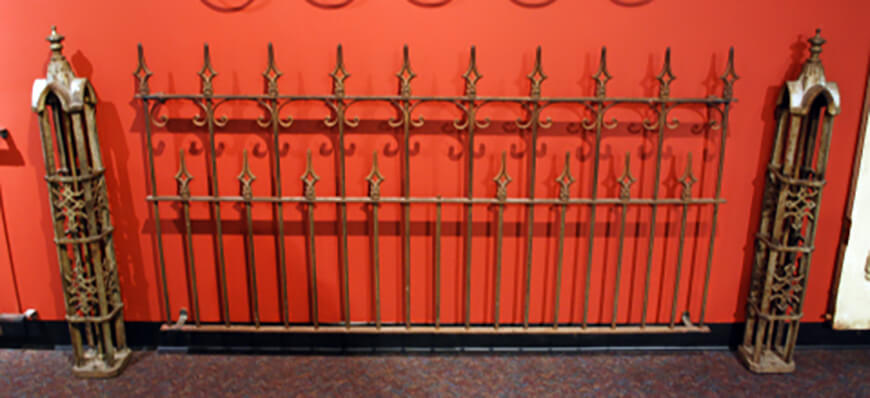This object is a section of a metal fence with a detailed design on the end posts. It is a lasting symbol of German-style architecture found throughout central Texas. Though German-Texas immigrants began mixing in Anglo building methods, some elements of German craftsmanship endured throughout the 19th and 20th centuries, and into today.
Germans are currently the third largest national-origin group in Texas, behind Anglos and Hispanics, comprising about 17.5% of the total population of the state. The majority of immigrants settled in a belt-like pattern, called “chain migration,” across the south central part of the state, forming a chain from Galveston along the coast, to Austin, New Braunfels, and San Antonio, and west into Kerrville, Mason, and Hondo on the far side of the Hill Country. Chain migration often occurs when immigrants enter a new place and settle there. They then start to branch out to farther points, creating a “chain” of connected communities- in this case, German communities.
The influence for so much migration to Texas was rooted in the so called “America Letters” that were written by immigrants, sent to their homelands, and often published. They sang the praises of their new homeland, and severely understated any downfalls. The letters were written by true pioneers who saw emigration as the solution to issues in their homeland, seeking economic, political, or religious opportunity.
In the case of Texas Germans, Friedrich Diercks was the most notable pioneer to bring attention to opportunities in Texas immigration. Originally intending to immigrate to Missouri, he switched gears when he heard about land grants being offered to European immigrants in Stephen F. Austin’s colony in Texas. Diercks applied for, and received over 4,000 acres in the northwest corner of Austin County (near Round Top, Texas).
As a result of the “America letters” written by Diercks, a steady stream of immigrants flowed into Texas from northwestern Germany. By 1850, the German Belt was well established. Towns like Fredericksburg and New Braunfels were founded during this time, and still house some of the largest concentrations of German descendants in Texas. Many of those people still speak German to each other.
The settlers who migrated during this time were by no means poor. They were generally solid middle-class peasants. Many were land- owners and artisans, and a few were college educated. The vast majority were farmers though. The Germans were ambitious though, and felt their futures in Germany were being stifled by their current social and economic system. In their new home of Texas, though many stayed in the cities such as Austin and San Antonio, many others moved to the rural areas of the Hill Country and farmed the land.
During the Civil War, migration was halted by the Union blockade of Confederate ports. Once the War ended though, more Germans than ever before arrived in Texas. Between 1865 and 1890, the number of German Texans jumped to over 40,000, and since 1930, the reach of German settlements has changed very little.
Before the World Wars, German heritage was widely preserved due to their relative isolation in their clustered colonies. However, due to German prejudice surrounding the World Wars, many folkways were lost, and many settlers stopped speaking German. As more and more of the Anglo- Texan culture intertwined with German heritage, even more of the pure German culture in Texas was lost.
Today, we still see the imprint of German culture in celebrations and historic architecture. Events like Oktoberfest, Saengerfest, and Wurstfest celebrate the culture that so many Texans have roots in. Buildings like Sunday Houses, and even modern German Texas farmhouse style homes, pay tribute to the heritage of 19th Century German immigrants.
Texas is a melting pot of heritage and has, in many ways, seamlessly accepted and tied together countless cultures and practices. From Hispanic, to Czech, to German, we all come together to celebrate what makes our state so unique.
